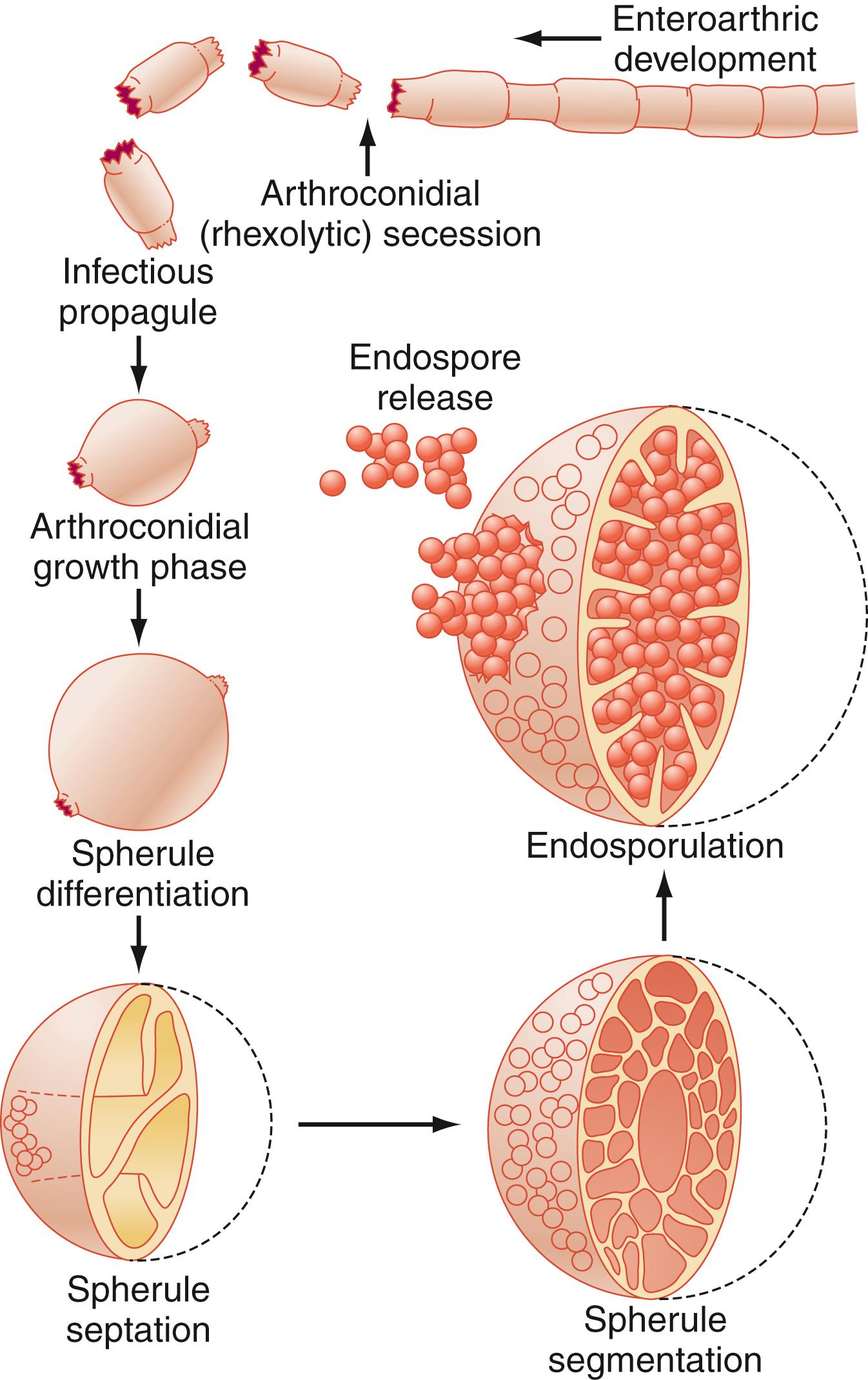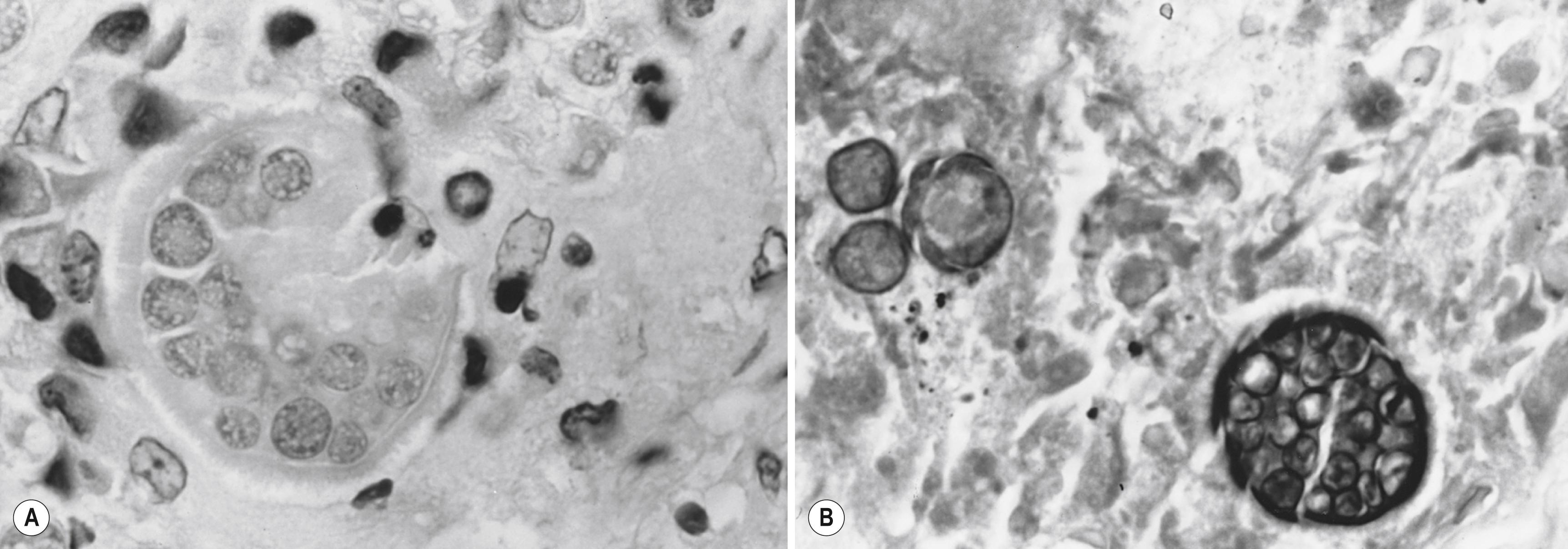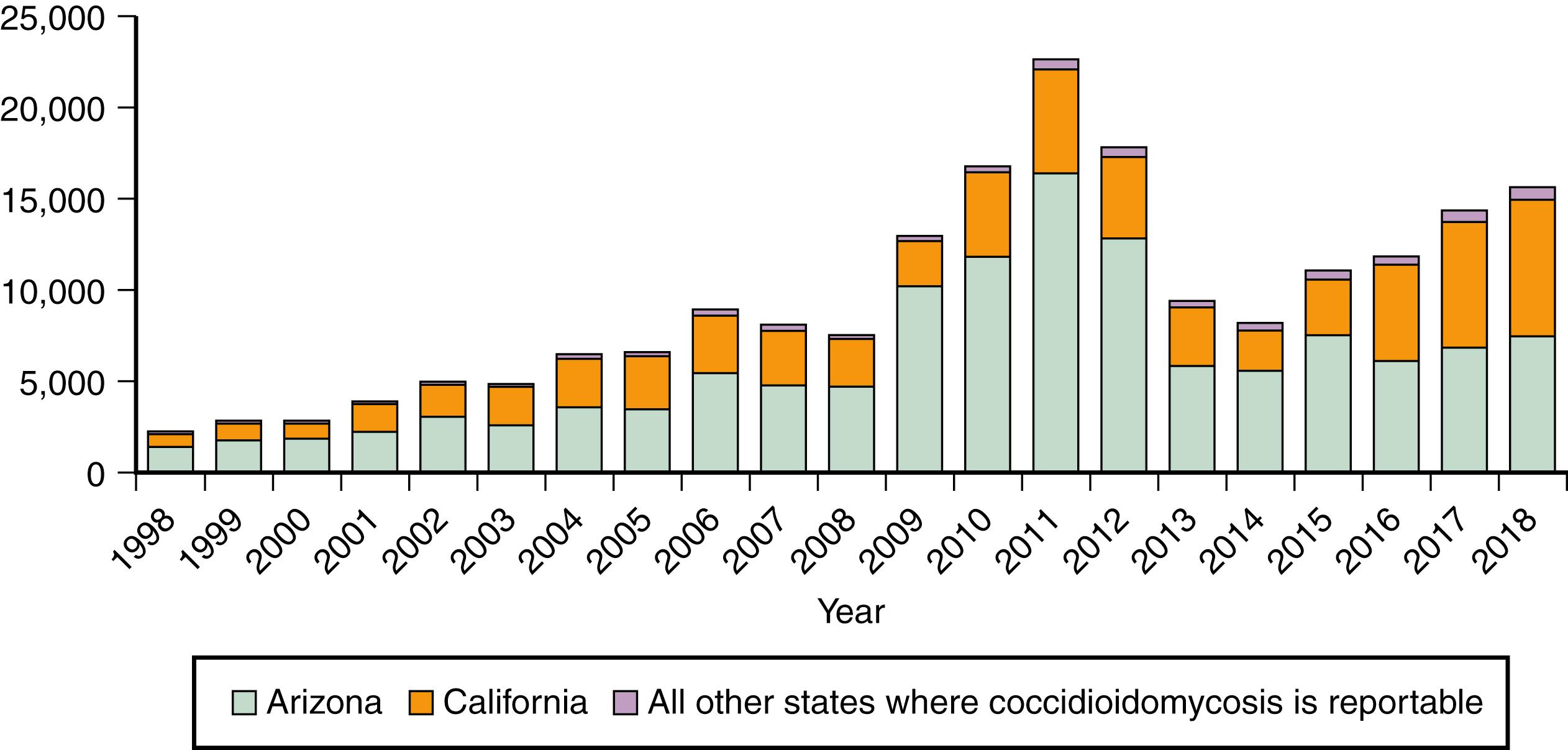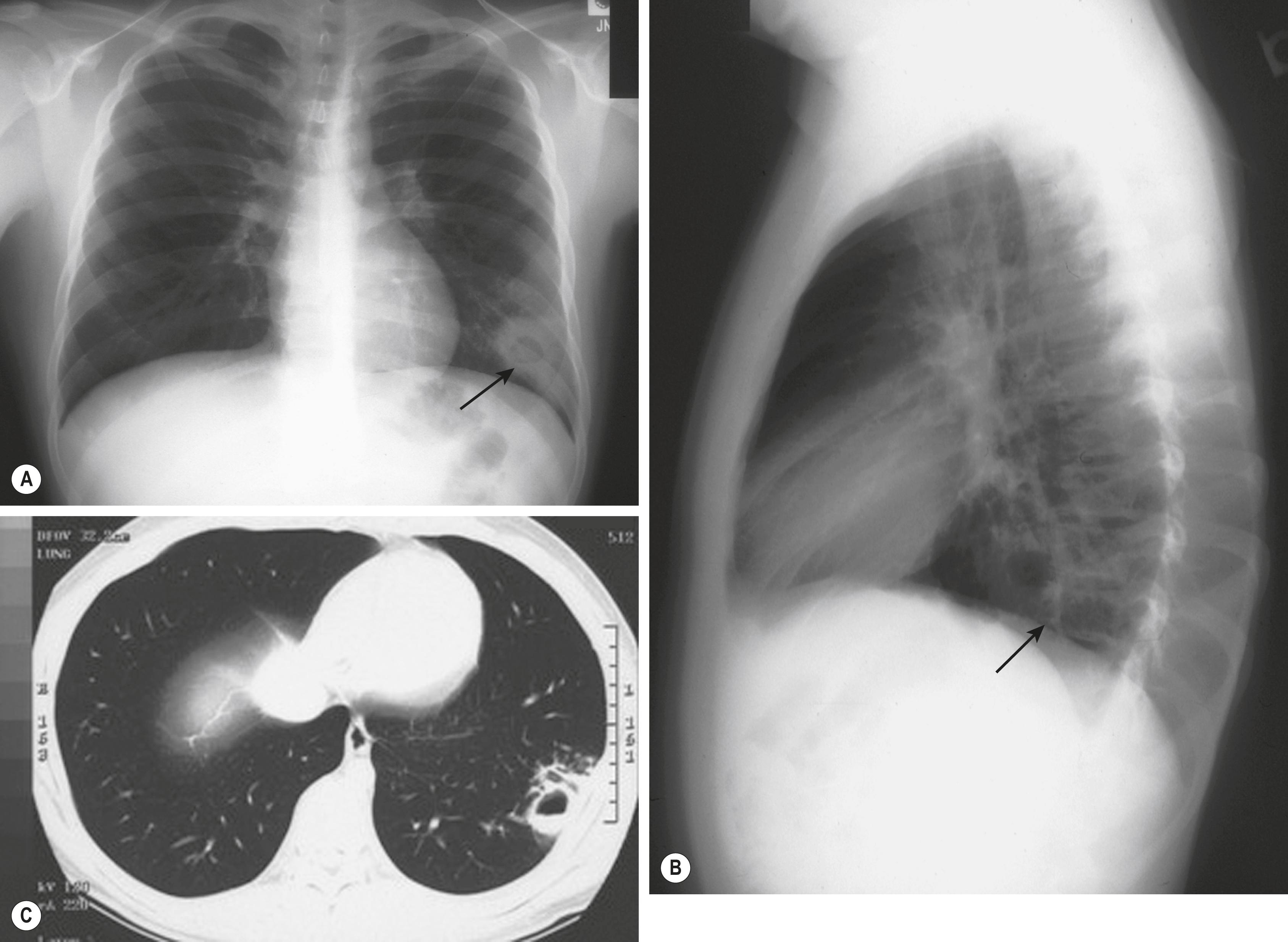Physical Address
304 North Cardinal St.
Dorchester Center, MA 02124
Coccidioidomycosis is an infection caused by the dimorphic fungi Coccidioides immitis and Coccidioides posadasii . These fungi are endemic to the southwestern US, Mexico, Guatemala, and sporadic regions within Central and South America. Infection is caused by inhalation of highly infectious and environmentally resistant spores following soil disruption and aerosolization. Primary infection is often manifest as an acute respiratory illness although the spectrum of disease ranges from asymptomatic exposure to severe and life-threatening disseminated disease.
Coccidioides spp. are dimorphic fungi that exist as spore-forming saprophytic molds in soil and as a spherule-endospore (SE) phase in vivo (yeast-like phase) ( Fig. 253.1 ). Two species have been identified using phylogenomic characterization, although additional potential species have been recently identified. Although these genomic differences clearly delineate two separate species, and differential thermotolerance found between them, no virulence or clinical differences have been described to date. C. immitis is found in California and Washington whereas C. posadasii is found primarily in Arizona, Mexico, and areas of Central and South America.

The infectious form of Coccidioides consists of desiccated spores (arthroconidia), which are “box-car”-shaped structures with thick hydrophobic walls. Spores are released from the mold when the thin-walled intervening cells disarticulate. Following inhalation, the spores germinate within the lung, and become spherules 10–80 μm in diameter over 3–4 days. Inhalation of only a few spores can cause infection in humans. Spherules undergo internal cleavage and septation and eventually release large numbers of endospores 2–5 μm in diameter ( Fig. 253.1 ). Endospores then enlarge, forming spherules, thereby completing the life-cycle. Growth of Coccidioides is stimulated by progesterone, 17β-estradiol, and testosterone and may significantly impact in vivo growth in the host. The mold form is rarely found in human tissue.
Primary infection occurs in the lungs. Neutrophils, lymphocytes, and monocytes influence fungal dimorphism toward the spherule phase. A fungal enzyme with elastase activity may facilitate spread of infection and increase inflammation. C. posadasii perturbs pulmonary surfactant proteins, potentially enabling disease progression. Molecular techniques have been used to examine specific genes that affect virulence, and a cell surface glycoprotein that is produced early in spherule development has been found a major contributor to pathogenicity. An initial neutrophilic inflammatory response does not control infection despite rapid phagocytosis of Coccidioides particles, and granulomatous inflammation eventually predominates. A characteristic histologic finding is granulomatous inflammation containing spherules and endospores ( Fig. 253.2 ).

Primary pulmonary infection, whether clinically apparent or asymptomatic, often is accompanied by dissemination of the fungus. Symptoms of extrapulmonary infection occur in ∼1% of infected patients, and virtually any organ system may be involved; however, the central nervous system (CNS), skin, and bone are those most often affected in cases of disseminated infection.
Despite complement-dependent chemotaxis induced by fungal elements, neutrophils and macrophages have a reduced capacity for intracellular killing of Coccidioides forms. Phagocytosis of spherules is physically difficult due to the size of these forms (up to 80 μm). A metalloproteinase produced during endosporulation interferes with host recognition, thereby impairing phagocytosis when these fungal elements are most susceptible. Fibrillar surface matrices also can both prevent effective leukocyte contact with spherules and isolate endospores from phagocytic fungicidal mechanisms.
Natural infection results in lifelong immunity. Polyclonal B-lymphocyte activation and increased serum complement fixation antibody (CF) titers develop in cases of severe infection, especially when coupled with loss of skin test reactivity, but humoral immunity is not completely protective. Protection has been firmly related to induction of Th 1 -associated immune responses. Coccidioidal antigens are processed and presented to T lymphocytes by macrophages and dendritic cells. This induces the production of interferon (IFN)-γ and other Th1 cytokines, which act by recruiting and activating immune effector cells. Stimulated coccidioidal-immune T lymphocytes interact with and activate macrophages and enhance phagosome–lysosome fusion and killing. A diminished Th1 response to C. immitis antigens has been demonstrated in patients with disseminated infections when compared with Th 1 responses in otherwise healthy subjects. The importance of Th17 immunity has been demonstrated for a number of fungal pathogens and murine models of coccidioidomycosis are similarly suggestive of the importance of this pathway. A variety of factors may contribute, including high concentrations of fungal antigen, circulating immune complexes, and direct suppression of immunity by fungal products or effectors. Congenital or acquired impairment of cellular immunity is a major risk factor for serious primary infection or relapse of past infection.
Coccidioidomycosis occurs in arid regions of the southwestern US and is endemic to southern California, western Washington, Utah, Arizona, western and southern Texas, and New Mexico. Most cases are reported as Valley Fever are from California and Arizona ( Fig. 253.3 ). Infection also occurs in regions of Mexico and Central and South America where biogeographic distribution probably resulted from a co-dispersal of the human host population and its pathogen. Environments with hot summers, infrequent freezes, alkaline soil, and alternating periods of rain and drought support fungal growth and aerosolization of arthroconidia. Analyses of epidemic strains have shown that outbreaks result from environmental distribution, rather than the emergence of a pathogenic subtype. ,

Infection usually is acquired during recreational or occupational activities that increase the likelihood of exposure to aerosolized arthroconidia. Examples include construction workers, military exercises, archeologic investigations, and recreational events. Outbreaks have also occurred following earthquakes, such as in 1994. The incidence of infections has increased in both Arizona and California from 2000 to 2018, with an 800% increase in cases in California over this time period. Infections can be difficult to diagnose when a traveler returns to a nonendemic area with practitioners with less experience in the diagnosis and care of coccidioidomycosis. Outbreaks also have occurred among travelers returning from regions not previously known to be endemic. Fomites, such as dusty clothing or agricultural products, also have been implicated as sources of infection and may account for cases well outside the established endemic region. , Person-to-person spread of coccidioidomycosis has not been documented via the respiratory route; however, infected bandages contaminated by purulent drainage have been implicated in transmission following the growth of arthroconidia on the bandages.
An estimated 150,000 new infections occur annually in the US. Rates are highest in fall and early winter. Coccidioidomycosis has become increasingly important as migration to sunbelt states (and accompanying construction) and the numbers of elderly and immunosuppressed populations within the endemic region grow. Skin test positivity has been found in 17% of children living in a highly endemic area for up to 1 year and in 77% of children living in an endemic area for ≥10 years. The return of skin testing reagents (Spherusol) to the commercial market may allow large scale epidemiologic testing to be performed; however, the sensitivity of this test appears to be lower than the prior formulation.
Infection is subclinical in roughly 60% of the exposed population, while most others have self-limited, primary pulmonary infections. Pulmonary complications occur in <5% and disseminated infections in <1% of infected people. Pulmonary complications and extrapulmonary infections can occur without recognized antecedent illness. Illnesses in children requiring hospitalization mirrored the increased incidence of disease in 2005–2006 and were more common among patients with comorbid conditions and those requiring surgical drainage.
The incubation period is 10–16 days (range, 1–4 weeks). Malaise, chest pain, and fever are common symptoms. , Cough is variable, and hemoptysis is unusual in children. Acute, diffuse, erythematous rash, and erythema multiforme are common. Erythema nodosum and fever can follow onset of symptoms by 3–18 days. Erythema nodosum and transient arthritic complaints (desert rheumatism) are mediated by the immune response. Occasionally, pulmonary symptoms are absent, and only hypersensitivity manifestations occur.
Symptoms usually improve without treatment in a few weeks to several months. In adults, 5%–10% of infections result in residual pulmonary nodules or thin-walled cavities, and patient education in these circumstances is paramount to avoid an inappropriate oncologic workup in the future. Rarely, primary pulmonary infections that result from exposure to large inocula are severe and progress to involve multiple areas of the lungs and can cause symptoms of adult respiratory distress syndrome (ARDS).
Chronic pulmonary complications are uncommon in children and usually occur in adults with diabetes mellitus or an immunocompromising condition. Chronic progressive pneumonia, lung cavities, and pulmonary nodules are the most common manifestations ( Fig. 253.4 ). Peripheral thin-walled cavities sometimes rupture into the pleural space and cause pyopneumothoraces.

Clinical manifestations of dissemination to extrapulmonary sites occur in about 0.5%–1% of patients, usually within several months of the primary pulmonary infection and rarely after 1 year. Dissemination is less frequent in children than in adults. Persistent fever is common, and frequently affected sites include the skin, bones, joints, and CNS. Those at highest risk are neonates and young infants, immunosuppressed patients, Filipinos/Oceanic ethnicity, African Americans, Native Americans, pregnant women, and during the early postpartum period. Patients who are receiving tumor necrosis factor (TNF) antagonists also are recognized to be at heightened risk ( Box 253.1 ).
Become a Clinical Tree membership for Full access and enjoy Unlimited articles
If you are a member. Log in here